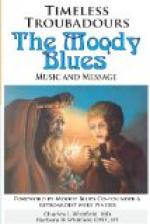Contemporary with Jaufre Rudel was Bernard de Ventadour, one of the greatest names in Provencal poetry. According to the biography, which betrays its untrustworthiness by contradicting the facts of history, Bernard was the son of the furnace stoker at the castle of Ventadour, under the Viscount Ebles II., himself a troubadour and a patron of troubadours. It was from the viscount that Bernard received instruction in the troubadours’ art, and to his patron’s interest in his talents he doubtless owed the opportunities which he enjoyed of learning to read and write, and of making acquaintance with such Latin authors as were currently read, or with the anthologies and books of “sentences” then used for instruction in Latin. He soon outstripped his patron, to whose wife, Agnes de Montlucon, his early poems were addressed. His relations with the lady and with his patron were disturbed by the lauzengiers, the slanderers, the envious, and the backbiters of whom troubadours constantly complain, and he was obliged to leave Ventadour. He went to the court of Eleanor of Aquitaine, the granddaughter of the first troubadour, Guillaume IX. of Poitiers, who by tradition and temperament was a patroness of troubadours, many of whom sang her praises. She had [47] been divorced from Louis VII. of France in 1152, and married Henry, Duke of Normandy, afterwards King of England in the same year. There Bernard may have remained until 1154, in which year Eleanor went to England as Queen. Whether Bernard followed




